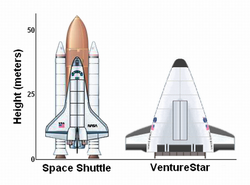VentureStar
 Simulated view of VentureStar in low Earth orbit | |
| Function | Manned Re-usable Spaceplane |
|---|---|
| Manufacturer | Lockheed Martin |
| Country of origin | United States |
| Size | |
| Height | 38.7 m[1] (127 ft) |
| Diameter | N/A |
| Mass | 1,000,000 kg[1] (2,200,000 lb) |
| Stages | 1 |
| Capacity | |
| Payload to LEO | 20,412 kg[1] (45,000 lb) |
| Launch history | |
| Status | Canceled |
| Launch sites | Unknown |
| Total launches | 0 |
| First stage - VentureStar | |
| Engines | 7 RS2200 Linear Aerospikes[1] |
| Thrust | 3,010,000 lb[1] (13.39 MN) |
| Propellant | LOX/LH2[1] |
VentureStar was a proposed spaceplane design for a single-stage-to-orbit reusable launch system by Lockheed Martin. The program's primary goal as a United States federally funded program was to develop a reusable unmanned spaceplane for launching satellites into orbit at a fraction of the cost of other systems that would completely replace the Space Shuttle. While the requirement was for an unmanned launcher, it was expected to optionally carry passengers as cargo.
VentureStar was to be a single-stage-to-orbit vehicle that would take off vertically and land like an airplane. VentureStar was to be a commercial endeavor, and flights would have been leased to NASA as needed. After failures with the X-33 subscale technology demonstrator test vehicle, funding was canceled in 2001.
Advantages over the Space Shuttle

VentureStar's engineering and design offered numerous advantages over the Space Shuttle, representing considerable savings in time and materials, as well as increased safety.[2] VentureStar could launch satellites into orbit at about 1/10 the cost of the Shuttle.
Readying VentureStar for flight would be dramatically different from that of the Space Shuttle. Unlike the Shuttle Orbiter, which must be lifted and assembled together with several other heavy components (a large external tank, plus two solid rocket boosters) the VentureStar would be simply inspected in a hangar like an airplane.[2]
Also unlike the Space Shuttle, VentureStar would have not relied upon solid rocket boosters which must be hauled out of the ocean and then refurbished after every launch.[2] Furthermore, the design specifications call for the use of linear aerospike engines, which maintain efficient thrust at all altitudes. The Shuttle relies upon the conventional nozzle engine which achieves maximum efficiency at only one specific altitude.[2]
VentureStar would have used a new metallic thermal protection system that would be safer and cheaper to maintain than the ceramic one on the Space Shuttle. VentureStar's metallic heat shield would eliminate 17,000 between-flight maintenance hours currently required to satisfactorily check (and replace if needed) each of the thousands of heat-resistant ceramic tiles which make up the Shuttle exterior.[2]
VentureStar was anticipated to be safer than modern rockets.[2] Whereas today's rockets, with the exception of the Falcon 9 which has engine out capability like the Saturn V did, fail catastrophically when an engine fails during flight, VentureStar would have a thrust reserve in each engine for the event of an emergency during flight.[2] For example, if an engine on VentureStar was to have failed during an ascent to orbit, another engine opposite to the failed engine would shut off to counterbalance the failed thrust, and each of the remaining working engines could have been throttled up so as to safely continue the mission.[2]
VentureStar would have been environmentally cleaner.[2] Unlike the Space Shuttle, whose solid rocket boosters expend chemical wastes during launch, VentureStar's exhausts would have been composed of only water vapor, since VentureStar's main fuels would be only liquid hydrogen and liquid oxygen.[2] VentureStar's simpler design would have excluded hypergolic propellants and even hydraulics, relying upon only electrical power instead for flight controls, doors and landing gear.[2]
Because of its lighter design, VentureStar would have been able to land at virtually any major airport in an emergency,[2] whereas the Space Shuttle requires much longer runways than publicly available.
Cancellation
Failures in VentureStar's technology demonstrator, the X-33, in particular with the composite LH2 (liquid hydrogen) tank, led to program cancellation as a federal undertaking on February, 2001. [3]
See also
References
- ^ a b c d e f "AeroSpace Online:X-33 Advanced Technology Demonstrator". Retrieved 2007-04-23.
- ^ a b c d e f g h i j k l "SP-4220 Wingless Flight: The Lifting Body Story (Chapter 9)". R. Dale Reed (NASA Dryden Flight Research Center, Aerospace and Contract Engineer). NASA. 1997. Retrieved 21 January 2010.
{{cite web}}: Unknown parameter|month=ignored (help) - ^ http://www.dfrc.nasa.gov/gallery/photo/X-33/HTML/EC96-43631-2.html | accessdate 18 April 2011}}
